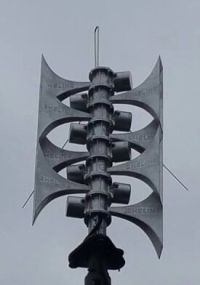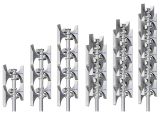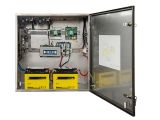SONUS: Difference between revisions
No edit summary |
No edit summary |
||
| (13 intermediate revisions by the same user not shown) | |||
| Line 1: | Line 1: | ||
''Not to be confused with the [[SONIA UTS]], a similar Romanian brand of siren produced by Axatel Service.'' | ''Not to be confused with the [[SONIA UTS]], a similar Romanian brand of siren produced by Axatel Service.''{{Infobox siren|image=SONUS-HES-1200.jpg|caption=A SONUS-HES-1200 in Arnsberg, NW. Photo credit to Rail Fan.|produced=≤2015-present|output=103-123 dBa @ 30 m (100 ft)|wattage=300-3000 W|voltage=110/250 V AC/12|current=DC|company=HELIN|type=[[Directional]]/[[Omnidirectional]] [[Electronic]]}} | ||
'''SONUS''', [[HELIN]]'s take on the [[Telegrafia]] [[PAVIAN]], is a brand of omnidirectional electronic warning sirens, 1 of 4 (formerly 5) offered, based in Hagen, NW. The SONUS brand has existed at least since 2015 and continues to rise in popularity in Germany year by year; while not quite as common as HÖRMANN or SiRcom's offerings, the HELIN SONUS continues to maintain at least somewhat of a foothold regionally and is scattered throughout the country. | |||
''' | == History == | ||
SONUS (model name ''SONUS-HES'' or simply ''HES'') was introduced by HELIN no later than 2015. The SONUS sirens were formerly accompanied by another series of sirens named the SONITUS, which was advertised as a "simpler" electronic siren that was integrable into other forms of notification such as SMS messaging and emergency lighting. This series was visually identical to the SONUS but lacked a 3000 W model. The SONITUS was short-lived, being removed from HELIN's siren website between July and October of 2016, and no units are known to exist. Like many of HELIN's other offerings, SONUS sirens are closely related to Telegrafia's sirens, which are made in Slovakia. SONUS formerly used Telegrafia hardware until 2022, when HELIN updated their controller design and started to use what appear to be [[SiRcom]] amplifiers in the SONUS control cabinets. This change occurred around the same time that both Telegrafia and [[Alertus]] updated their hardware. It is speculated that the changes are tied to each other given that they happened at around the same time. | |||
== | == Design == | ||
[[File:Sirene-Sonitus-1 0.jpg|left|thumb|160x160px|A render of (almost) every SONUS line siren.]] | [[File:Sirene-Sonitus-1 0.jpg|left|thumb|160x160px|A render of (almost) every SONUS line siren. The filename on HELIN's website interestingly refers to these as SONITUS sirens.]] | ||
SONUS | SONUS sirens utilize several thin rectangular horns with a triangular side profile made of corrosion-resistant sheet steel. 150 W drivers for each horn power the siren, with cylindrical-shaped enclosures shielding each driver from the elements. The design of the horns and drivers are sourced from HÖRMANN's [[HÖRMANN ECX|ECN]], as its speaker design is very efficient and extremely influential as a result of the design being licensed to other manufacturers (and in some cases copied), resulting in many other sirens looking similar, if not identical to the ECN series, with the only changes being the logos on the sides of the horns. The SONUS horns have HELIN's logo branded on them and were most likely produced in-house. | ||
The similar horns make telling the sirens that use these designs apart quite difficult without close inspection, and many confuse sirens that share the same horns and drivers | The similar horns make telling the sirens that use these designs apart quite difficult without close inspection, and many confuse sirens that share the same horns and drivers. The minimum number of speakers the SONUS supports is 2 (300 W), and the maximum is 20 (3000 W). The speakers are bolted together by cylindrical connector pieces behind the throat of each horn and allow for the speakers to be configured in a variety of ways; in most cases, they are arranged in a way where the sound is propagated omnidirectionally, with the principle being based on gap diffraction (also called Huygens' principle). The SONUS sirens run on 110-250 V AC/12 V DC, powered by 2 maintenance-free AGM rechargeable lead acid batteries, and utilize 1 to 10 Class D amplifiers, with optional automatic switching to a reserve amplifier). [[File:Sirene-Sonitus-2 0.jpg|thumb|160x160px|The controller used on SONUS sirens.]]An SD card stores a variety of signals and messages able to be broadcast through the siren. The SONUS has a standby time of 7-30 days maximum, can run while disconnected from the main power supply for at least 48 hours, and also comes with an optional live PA function. Telegrafia's Vektra software, of which these sirens as well as external notification systems can be integrated with, allows for remote monitoring and activation of the sirens, among other features. The status of a siren's power supply, drivers, amplifier, and batteries are also able to be monitored, and logs of important events in an internal memory can be viewed through the software. Each siren can be activated via GSM mobile telephony, Ethernet TCP/IP protocol networks, a dedicated telephone line, or a dedicated VHF/UHF radio frequency. SONUS is also available with 8 configurable binary/analog inputs (and optional additional inputs), 2 RS232 ports, 2 USB ports, and LAN interfaces. All of the SONUS control components are housed in a square stainless steel or powder-coated IP55 weather-resistant cabinet. | ||
[[File:Sirene-Sonitus-2 0.jpg|thumb|160x160px|The controller used on SONUS sirens.]] | |||
An SD card stores a variety of signals and messages able to be broadcast through the siren. The SONUS has a standby time of 7-30 days maximum, can run | |||
All of the SONUS control components are housed in a square stainless steel or powder-coated IP55 weather resistant cabinet | |||
The SONUS' output, as rated by HELIN, is 103 to 123 dBa at 30 m (100 ft). The sirens have an operating temperature range of -25°C (-13°F) to +65°C (149°F), weigh between 23 kg (50.7 lbs, w/o batteries)/34 kg (74.9 lbs, w/ batteries) and 59 kg (130 lbs, w/o batteries)/105 kg (231.4 lbs, w/ batteries), and are measured between 600 x 380 x 300 mm (WxHxD) and 600 x 770 x 300 mm. Specifications for individual sirens in the SONUS lineup are listed in the table below. | The SONUS' output, as rated by HELIN, is 103 to 123 dBa at 30 m (100 ft). The sirens have an operating temperature range of -25°C (-13°F) to +65°C (149°F), weigh between 23 kg (50.7 lbs, w/o batteries)/34 kg (74.9 lbs, w/ batteries) and 59 kg (130 lbs, w/o batteries)/105 kg (231.4 lbs, w/ batteries), and are measured between 600 x 380 x 300 mm (WxHxD) and 600 x 770 x 300 mm. Specifications for individual sirens in the SONUS lineup are listed in the table below. | ||
| Line 103: | Line 100: | ||
[[Category:Directional Sirens]] | [[Category:Directional Sirens]] | ||
[[Category:European Sirens]] | [[Category:European Sirens]] | ||
[[Category:HELIN]] | |||
Latest revision as of 16:50, 25 November 2024
Not to be confused with the SONIA UTS, a similar Romanian brand of siren produced by Axatel Service.
| SONUS | |
 A SONUS-HES-1200 in Arnsberg, NW. Photo credit to Rail Fan. | |
| Company | HELIN |
|---|---|
| Produced | ≤2015-present |
| Type | Directional/Omnidirectional Electronic |
| Sound output | 103-123 dBa @ 30 m (100 ft) |
| Wattage | 300-3000 W |
| Voltage | 110/250 V AC/12 V DC |
SONUS, HELIN's take on the Telegrafia PAVIAN, is a brand of omnidirectional electronic warning sirens, 1 of 4 (formerly 5) offered, based in Hagen, NW. The SONUS brand has existed at least since 2015 and continues to rise in popularity in Germany year by year; while not quite as common as HÖRMANN or SiRcom's offerings, the HELIN SONUS continues to maintain at least somewhat of a foothold regionally and is scattered throughout the country.
History
SONUS (model name SONUS-HES or simply HES) was introduced by HELIN no later than 2015. The SONUS sirens were formerly accompanied by another series of sirens named the SONITUS, which was advertised as a "simpler" electronic siren that was integrable into other forms of notification such as SMS messaging and emergency lighting. This series was visually identical to the SONUS but lacked a 3000 W model. The SONITUS was short-lived, being removed from HELIN's siren website between July and October of 2016, and no units are known to exist. Like many of HELIN's other offerings, SONUS sirens are closely related to Telegrafia's sirens, which are made in Slovakia. SONUS formerly used Telegrafia hardware until 2022, when HELIN updated their controller design and started to use what appear to be SiRcom amplifiers in the SONUS control cabinets. This change occurred around the same time that both Telegrafia and Alertus updated their hardware. It is speculated that the changes are tied to each other given that they happened at around the same time.
Design

SONUS sirens utilize several thin rectangular horns with a triangular side profile made of corrosion-resistant sheet steel. 150 W drivers for each horn power the siren, with cylindrical-shaped enclosures shielding each driver from the elements. The design of the horns and drivers are sourced from HÖRMANN's ECN, as its speaker design is very efficient and extremely influential as a result of the design being licensed to other manufacturers (and in some cases copied), resulting in many other sirens looking similar, if not identical to the ECN series, with the only changes being the logos on the sides of the horns. The SONUS horns have HELIN's logo branded on them and were most likely produced in-house.
The similar horns make telling the sirens that use these designs apart quite difficult without close inspection, and many confuse sirens that share the same horns and drivers. The minimum number of speakers the SONUS supports is 2 (300 W), and the maximum is 20 (3000 W). The speakers are bolted together by cylindrical connector pieces behind the throat of each horn and allow for the speakers to be configured in a variety of ways; in most cases, they are arranged in a way where the sound is propagated omnidirectionally, with the principle being based on gap diffraction (also called Huygens' principle). The SONUS sirens run on 110-250 V AC/12 V DC, powered by 2 maintenance-free AGM rechargeable lead acid batteries, and utilize 1 to 10 Class D amplifiers, with optional automatic switching to a reserve amplifier).

An SD card stores a variety of signals and messages able to be broadcast through the siren. The SONUS has a standby time of 7-30 days maximum, can run while disconnected from the main power supply for at least 48 hours, and also comes with an optional live PA function. Telegrafia's Vektra software, of which these sirens as well as external notification systems can be integrated with, allows for remote monitoring and activation of the sirens, among other features. The status of a siren's power supply, drivers, amplifier, and batteries are also able to be monitored, and logs of important events in an internal memory can be viewed through the software. Each siren can be activated via GSM mobile telephony, Ethernet TCP/IP protocol networks, a dedicated telephone line, or a dedicated VHF/UHF radio frequency. SONUS is also available with 8 configurable binary/analog inputs (and optional additional inputs), 2 RS232 ports, 2 USB ports, and LAN interfaces. All of the SONUS control components are housed in a square stainless steel or powder-coated IP55 weather-resistant cabinet.
The SONUS' output, as rated by HELIN, is 103 to 123 dBa at 30 m (100 ft). The sirens have an operating temperature range of -25°C (-13°F) to +65°C (149°F), weigh between 23 kg (50.7 lbs, w/o batteries)/34 kg (74.9 lbs, w/ batteries) and 59 kg (130 lbs, w/o batteries)/105 kg (231.4 lbs, w/ batteries), and are measured between 600 x 380 x 300 mm (WxHxD) and 600 x 770 x 300 mm. Specifications for individual sirens in the SONUS lineup are listed in the table below.
| Model | Drivers/wattage | Amplifiers | Amp hours | Standby time | Activations within 48 hours of mains power disconnect | dBa @ 30m (100 ft) | Weight | Dimensions (WxHxD) |
|---|---|---|---|---|---|---|---|---|
| SONUS-HES-300 | 2 (300 W) | 1 | 18 Ah | >7 days | >48 | 103 | 23 kg (50.7 lbs, w/o batteries)/34 kg (74.9 lbs, w/ batteries) | 600x380x300 mm |
| SONUS-HES-600 | 4 (600 W) | 2 | 26 Ah | >10 days | >38 | 109 | 25 kg (55.1 lbs, w/o batteries)/41 kg (90.3 lbs, w/ batteries) | 600x380x300 mm |
| SONUS-HES-900 | 6 (900 W) | 3 | 50 Ah | >20 days | >50 | 112.5 | 28 kg (61.7 lbs, w/o batteries)/57 kg (125.6 lbs, w/ batteries) | 600x380x350 mm |
| SONUS-HES-1200 | 8 (1200 W) | 4 | 50 Ah | >20 days | >40 | 115 | 30 kg (66.1 lbs, w/o batteries)/59 kg (130 lbs, w/ batteries) | 600x380x300 mm |
| SONUS-HES-1800 | 12 (1800 W) | 6 | 50 Ah | >20 days | >27 | 118.5 | 43 kg (94.7 lbs, w/o batteries)/72 kg (158.7 lbs, w/ batteries) | 600x600x300 mm |
| SONUS-HES-2400 | 16 (2400 W) | 8 | 78 Ah | >30 days | >30 | 121 | 47 kg (103.6 lbs, w/o batteries)/93 kg (205 lbs, w/ batteries) | 600x600x300 mm |
| SONUS-HES-3000 | 20 (3000 W) | 10 | 78 Ah | >30 days | >26 | 123 | 59 kg (130 lbs, w/o batteries)/105 kg (231.4 lbs, w/ batteries) | 600x770x300 mm |